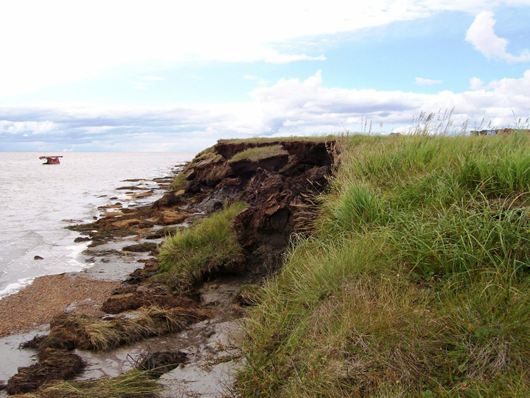On Alaska’s coast, one threatened community is getting closer to relocation
After years of preparation, Newtok may have the elements of a new village in place by this fall.

After many years of deliberation and nervous anticipation, the residents of Newtok are on the move to higher ground.
It’s been a long time coming for the 350 residents of the Southwest Alaska village that is threatened by erosion and climate change.
The Ninglick River has moved to within about 10 yards of the first home, which is why the construction of 13 new homes this summer on the new village site is a welcome relief.
The new village is 12 miles away on Nelson Island, at a site called Mertarvik. By this fall, the basic elements of a new village may be in place.
A community center is nearing completion and there is road work taking place in addition to the home construction and development of a rock quarry. A power plant, assembled in Anchorage, is to be shipped to the site. The move is a step-by-step approach.
“A few families are living there now and the big push is happening this summer. There will be 13 new homes complete, the due date for completion is October,” said architect Aaron Cooke, who has helped with this project in one way or another for more than a decade.
Cooke is part of a team from the Cold Climate Housing Research Center working on the relocation project.
Some of the homes at the old village site are being demolished before the river takes them out. The community center will be readied for use as a school.
“These folks are definitely moving. It will really come to whether all 13 families move right away. If all 13 move and there are several families already at the site, there may be enough kids for a school at Mertarvik.”
“It’s a big unknown. Things are looking good, but you never know,” he said.
Newtok has received international attention in recent years and become something of a poster child for the dozens of villages in Alaska facing threats from flooding and erosion.
Climate change in Alaska could cause from $4 billion to $5 billion in infrastructure damage this century, according to one recent study, with Newtok on the leading edge of climate refugees.
Of the Alaska villages facing the most imminent threats — Newtok, Shishmaref, Kivalina, and Shaktoolik — Newtok is the only one on the verge of a successful move.
While elsewhere along the Alaska coast, the loss of sea ice has been a major threat, Newtok has had to face a slow-moving disaster for decades.
Up to 70 feet of shoreline has disappeared in some years and now time is running out.
The positive thing here is that the advance warning given by the eroding river has provided plenty of time to plan and seek funding for the move.
The village first voted to move in 1994, prompted by knowledge that the river channel was on the move.
One factor that helped Newtok decide is that Nelson Island is a safe spot with lots of rock and a good place for a village.
“They were able to create a sensible plan for laying out the new community so that when it came time, when the erosion got close enough to the very first houses, they knew what to do, they didn’t wait for that day to come,” Cooke said.
More than $50 million has been spent on development at the new site, funds assembled from a variety of federal and state sources on an incremental basis.
The most recent boost came in 2018 with a $15 million grant from Congress.
Some of the most expensive infrastructure has yet to be funded and the timing is uncertain. About 20 additional houses are expected to be built next summer.
The river erosion at Newtok has long been obvious to everyone, a realization that limited internal debate and created a sense of urgency.
The new site can be reached by boat in the summer, and by snowmachine in the winter, which leaves extended periods in the spring and fall when transportation is difficult or impossible. Those weeks and months of uncertainty prompted some villages to not make the move permanent just yet.
A temporary runway has been established, however, and that may make ease that particular issue.
The old site is expected to remain in use until there is housing for all in Mertarvik, which may take a few years more, though houses in danger of being swept away are being removed to prevent pollution.
Dermot Cole can be reached at de*********@gm***.com.